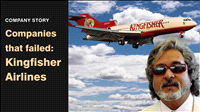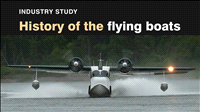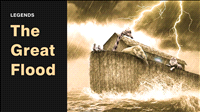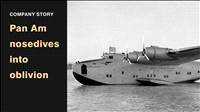Flying boats history | Seaplanes | Industry study
By Kiron Kasbekar | 02 May 2023
Today I am going to talk about flying boats.
You heard that right – flying boats! Well, you can think of them as boats that can fly or as aircraft that float on water. Some of these vehicles can also land on, and take off from, land.
It’s possible you’ve never seen these aircraft. And if you have not, that would not be surprising. For these aircraft can be seen only in some parts of the world today.
Unlike the big passenger planes we are accustomed to seeing, flying boats can be seen only in a few locales. As on lakeshores. Or on calm rivers and seas in a few countries.
Flying boats, which are planes that can land in water and take off from water, or amphibian aircraft, as they are called when they also operate on solid ground, were popular in the past, in the 1930s and 1940s.
That was a time when aircraft were propeller-driven. Speeds were much lower than they are today.
Landing a modern jet aircraft on water is dicey. Which is why you don’t see jet aircraft landing on water. Except in an emergency. As when US Airways Flight 1549 landed in the Hudson River, off New York City, on 15 January 2009. That landing was called the Miracle on the Hudson – for all 155 passengers and crew survived.
Why they called it a miracle was that landing a plane on water, known as ‘ditching’ (which means making a forced landing), can be extremely dangerous. A plane can go nose-first into the water and sink, or cartwheel and break up, and sink. Sink fast because of its weight.
In the 1930s and 1940s aviation was a new business, and airfields on land were just beginning to be built. So it was convenient to have aircraft that could land in water. That required very little infrastructure compared to airfields on terra firma, i.e., the ground.
Compared to the costs and complications of building the airport infrastructure on land, landing on any available water body, near a sea or river beach, was simple. Very little construction was involved.
So the early history of airlines is full of flying boats. In the 19th century everybody who lived near a stretch of water knew about boats and ships. But airships? Or aeroplanes of any kind? That was the stuff of imagination, and not too many people could even imagine such a thing.
The first powered flight in an aeroplane happened on 17 December 1903. That was when Orville Wright made his 12-second, 37-metre flight in North Carolina, USA, in his plane, the Kitty Hawk. Just 37 meters, but it was the first sustained and powered, heavier-than-air human flight. Why do I say, ‘heavier-than-air’? Because lighter-than-air balloon, or dirigible flights had been made before.
The plane that flew on 17 December 1903 was designed and built by Orville Wright and his elder brother, Wilbur.
Around that time there were several pioneers out there trying to make a mark in the aviation industry, among them stunt fliers known as ‘barnstormers’, who would fly in low, down to barn height, to display their skills. With the novelty wearing off and the US government’s flight regulations becoming tougher, that era came to an end in the 1930s.
Anyway, the big leap into the sky came with the launch of Pan American Airways in 1927. Pan Am used a four-engine Sikorsky S-42 flying boat, and then Boeing flying boats, and expanded its operations first across the Caribbean Sea and then across the Pacific and Atlantic oceans.
I have discussed Pan Am’s origins in another video. The link to that video is given below.
Flying boats on reconnaissance flights played a crucial part in some of the biggest naval battles of the Second World War. For example, pilots in Catalina flying boats located the Japanese carriers at Midway. Flying boats also helped locate the German battleship Bismarck.
The Catalina was a versatile plane that could land both on water and on runways on land. It could drop torpedoes, depth charges, and bombs, and defend itself with multiple high-caliber machine guns.
The Consolidated Model 28, more commonly known as the PBY Catalina (as the US Navy designated it), was an amphibious aircraft that was produced in the 1930s and 1940s. As many as 3,308 of these aircraft were built. And built in three different countries. As many as 2,661 were built in the USA, 620 in Canada, and 27 in the Soviet Union.
What’s remarkable about this aircraft is that it continues to fly today. Although the last military PBYs served until the 1980s, the aircraft continued to fly as a water-bomber (or air-tanker) in aerial firefighting operations in some parts of the world - even as recently as 2021, 86 years after its first flight.
Some of the companies that are big in the aerospace business today designed and manufactured flying boats in the past.
They include Boeing and Sikorsky, both American firms, which survive to this day, and companies like Sopwith, a British company, which did not survive.
Companies started and shut down, or were swallowed up by other companies, which in turn were swallowed up by yet others.
Saunders-Roe Limited, also known as Saro, was one such firm, a British aero- and marine-engineering company based in the Isle of Wight in the UK.
The firm was the result of a 1929 transaction in which British aerospace pioneer Alliott Verdon Roe and John Lord took a controlling interest in S. E. Saunders, an aircraft- and boat-building firm.
Sam Saunders, the founder, had earlier helped build the Sopwith/Saunders Bat Boat using ‘consuta’, a material he had developed for use in marine and aviation craft. The word consuta means ‘sewn together’ in Latin.
Consuta was a technique patented by Sam Saunders, which was used in the construction of watertight hulls for boats and marine aircraft. The technique involved interleaving four veneers of mahogany planking with waterproofed calico cloth and stitching the lot together with copper wire.
The technique was first used to restore an 1898 steam launch named Consuta, which returned to service on the River Thames on 15 October 1901. The technique was used to build the gondolas for Britain's first airship, the HMA1 Mayfly. That airship never took off because it split in two while being maneuvered in the shipyard.
But the consuta material continued to be used for decades afterwards for various other applications. It was used to construct the hull of the prize-winning Sopwith Bat Boat. And it continued to be used for boat hulls.
Saunders Roe concentrated on producing flying-boats. None, however, were produced in very large quantities – the most being 31 Londons.
Another company, Short Brothers of the UK, built the Short S.25 Sunderland, a flying boat patrol bomber for the Royal Air Force. The company made 749 of these planes before they were retired.
Air France and American Export Airlines (AEA) were two other airlines that used seaplanes, as did many others..
There were many remarkable successes. And there were some resounding failures. One of the big, I mean, really big, failures, was the Caproni Ca.60 Transaereo, also known as the Noviplano (meaning, nine-winged). The plane was also called Capronissimo, which, in Italian, means goofy, or eccentric.
The Capronissimo was the prototype of a large nine-wing flying boat, which, its maker, Giovanni Battista Caproni, hoped to build as a 100-passenger transatlantic airliner. The plane had eight engines and three sets of triple wings.
Only one model of this aircraft was built by the Caproni company, and tested on Lake Maggiore in early 1921. On 4 March, on its second flight the aircraft crashed soon after takeoff, landed on the water and broke up. It suffered further damage as the wreck was towed to shore.
Caproni wanted to rebuild the aircraft, but gave up the idea because the cost was too high.
There is also the story of the Spruce Goose, which flew only once. The Spruce Goose was a project started by billionaire Howard Hughes Jr, an American business magnate, record-setting pilot, engineer, film producer, and philanthropist, one of the most influential and richest people in the world during his lifetime.
On 2nd November 1947, this remarkable aircraft flew for the first and last time.
In 1942, during the Second World War, American ships were being battered and sunk in the Atlantic Ocean by U-boats, the German submarines. A way had to be found to avoid the U-boats. The easy answer was to transport troops and supplies to Europe by air.
Henry J. Kaiser, American industrialist and shipbuilder, proposed working with Howard Hughes, to create the largest aircraft ever to have been built. It was codenamed HK-1, and it was expected to carry up to 68 tonnes of cargo, plus 750 troops or two 30-ton M4 battle tanks.
The plane was expected to be made of wood. The wood used was a composite of plywood and birch resin.
The plane had the biggest wingspan in the world then –97.82 meters, and it was powered by eight engines. Weighing over 181 tonnes, it was expected to carry more cargo than any plane before it.
It never did that. The plane’s designers had spent so much time looking for perfection that by the time the plane was ready, the war was long over. The plane was two years too late.
The result was that it now had no use.
Flying boats were used all over the world, especially along coasts, to patrol against incursions by enemy craft, and for rescue operations.
One of the most important reasons that made flying boats popular between the 1920s and 1940s was that they could land on a sea or a lake, or even on a calm river. Meaning, they didn’t need a landing strip to land on.
So, in the 1930s, unlike today, there weren’t too many airstrips in the world. For one, there weren’t that many aircraft to make it worthwhile to build an airport on land. Building an airstrip was expensive. Landing airplanes in water needed no airstrip. Just a wharf would do.
Still, landing in a rough sea was a problem, and that was one reason why the use of seaplanes (which was another name for these aircraft) eventually tapered off.
Also, post-Second World War requirements changed dramatically. Jet engines had made their entry into the world of aviation, and they proved vastly superior to the older, propeller-driven planes.
With aircraft acquiring such great speeds as jet engines enabled, taking off from water and landing on water ceased to be possible.
In the past fifty years over four dozen flying boats have been launched and used. They include planes made by 15 countries (in alphabetical order): Brazil, Canada, China, Finland, France, Germany, Italy, Japan, New Zealand, Norway, Russia, Sweden, UK, US, and Vietnam.
Now let’s come to some modern flying boats. Here is one, the Us-2_03l, made by Japanese company, ShinMaywa. This plane seems to be among the best choices for marine reconnaissance and rescue. One of its strong points is that it can operate in conditions where the wave height is as much as three meters.
A few small companies clung on to the niche market for flying boat services. They are mostly small aircraft – nothing like the old flying boats that flew in the 1930s.
It is a small industry, and is expected to remain small. The global amphibious aircraft market size was valued at $164.4 million in 2021. Compare that with the global market for commercial aircraft, estimated at $126.9 billion in 2022.




























